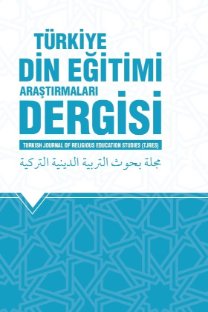Tanıkların Dilinden Sovyetler Birliği Döneminde Müslümanlara Uygulanan Din Politikaları: Kırgızistan Örneği
Sovyetler Birliği, Din, Politika, Ateizm, Kırgızistan
From the Language of Witnesses Religious Policies Applied to Muslims in The Soviet Union Period: The Case of Kyrgzstan
Soviet Union, Religion, Policy, Atheism, Kyrgyzstan,
___
- Babataev, A. (2018). SSCB Eğitim sistemi ve ateizm propagandası. Oş Devlet Üniversitesi İlahiyat Fakültesi Dergisi, (25), 87-98.
- Codevilla, G. (2008). Relations between church and state in Russia today. Religion, State and Society, 36(2), 113-138. http://doi.org/10.1080/09637490802013198
- Kozyrev, F. and Schilalejev, O. (2008). Religion and education in Estonia and Russia: resemblances and differences. Encountering Religious Pluralasm in School and Society, (5), 309-326.
- Kravchouk, Veronika V. (2004). New religious movements and the problem of extremism in modern Russia. Brigham Young University Law Review, (6), 507-533.
- Luukkanen, A. (1994). The party of unbelief: the religious policy of the Bolshevik party, SHS.
- Mambetaliev S. (1974). İslam’dın canı şartka caraşa kubuluşu, Frunze.
- Musahan, A. Y. (2015). Sovyet rejiminin müslümanlar üzerindeki inanç, ahlak ve aile politikası. İLTED, 2(44), 227-246. http://doi.org/10.29288/ilted.308481
- Neuman, W. L. (2012). Toplumsal araştırma yöntemleri: nicel ve nitel yaklaşımlar. (S. Özge, Çev.). Yayın Odası Yayınları.
- Preston, R. C. (2001). Islam in Russa under the federal law on freedom of conscience and on religious associations: official tolerance in an intolerant society. Brigham Young University Law Review, (2), 773-815.
- Riegel, K. G. (2005). Marxism-Leninism as a political religion. Totalitarian Movements andPolitical Religions, 6(1), 97-126. http://doi.org/10.1080/14690760500099788
- Saraç, H. (2019). Kutsalı topyekün dönüştürme çabası: Lenin ve Stalin döneminde ovyetler Birliği’nin din politikası. Kafkas Üniversitesi Sosyal Bilimler Enstitüsü Dergisi, (23), 73-96.
- Tecer, Ö. Ç. (2013). Sovyet ateizmi ve Orta Asya’daki etkileri (1917-1939). Abant İzzet Baysal Üniversitesi, Sosyal Bilimler Enstitüsü.
- Turunen, M. (2007). Orthodox monarchism in Russia is religion important in the present-day conctruction of national identity? Religion, State and Society, 35( 4), 319-334.
- Walters, P. (1986). The Russian orthodox church and the soviet state. Annals of the American Academy of Political and Social Science, (483), 135-145.
- Yıldırım, A. ve Şimşek, H. (2008). Sosyal Bilimlerde Nitel Araştırma Yöntemleri, Seçkin Yayınları.
- ISSN: 2149-9845
- Başlangıç: 2016
- Yayıncı: Mehmet BAHÇEKAPILI
Osmanlı Son Dönemi ile Cumhuriyet Dönemini İdrak Etmiş Bursalı Mutasavvıf Mûsikîşinaslar
Bir Peygamber Olarak Hz. İbrahim’in Dualarındaki Tasavvufî ve Psikolojik Temalar
Velilere Göre 4-6 Yaş Kur’an Kursları (Van Örneği)
Arap Dilbilimi Yazmaları: Cadbury Araştırma Kütüphanesi Mingana Özel Koleksiyonu
İlahiyat Eğitim Sürecinin Ahlaki Yargı Gelişimine Etkisi
